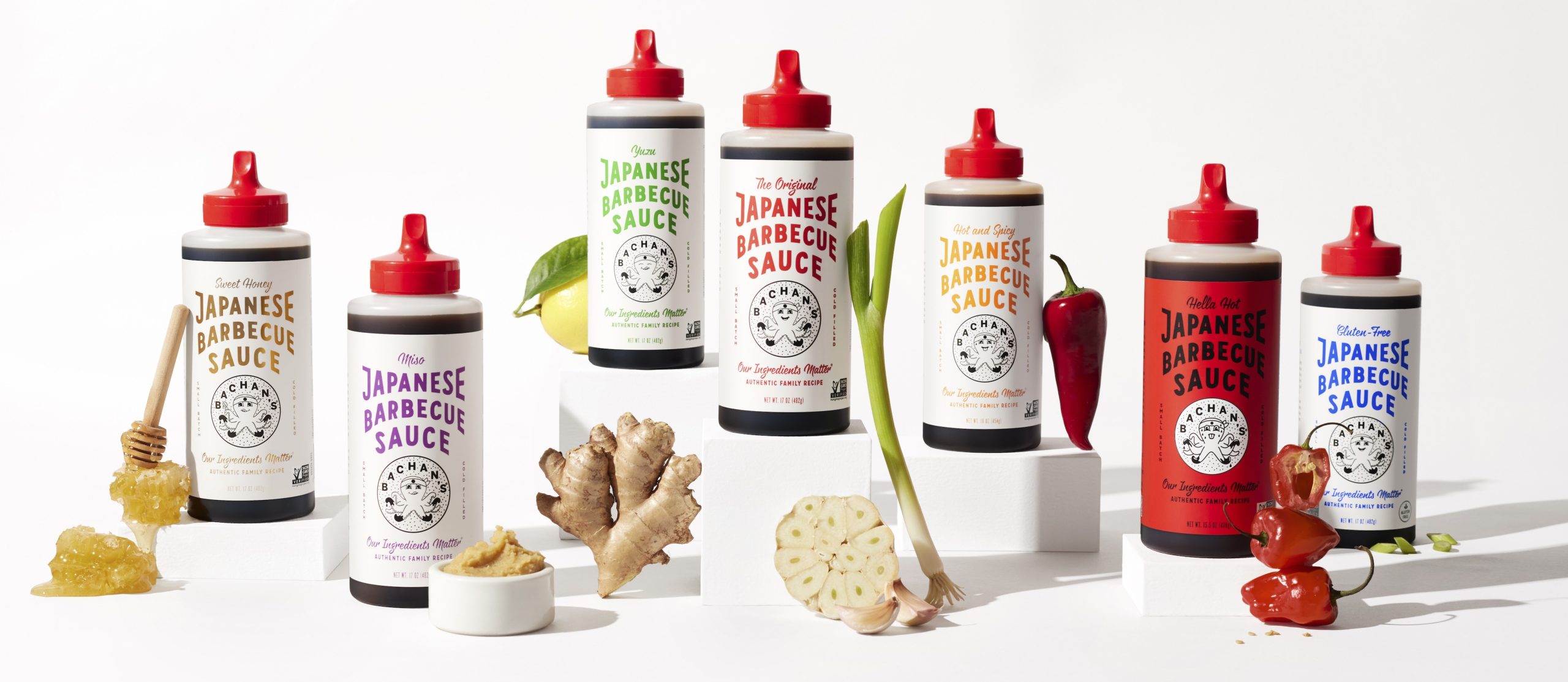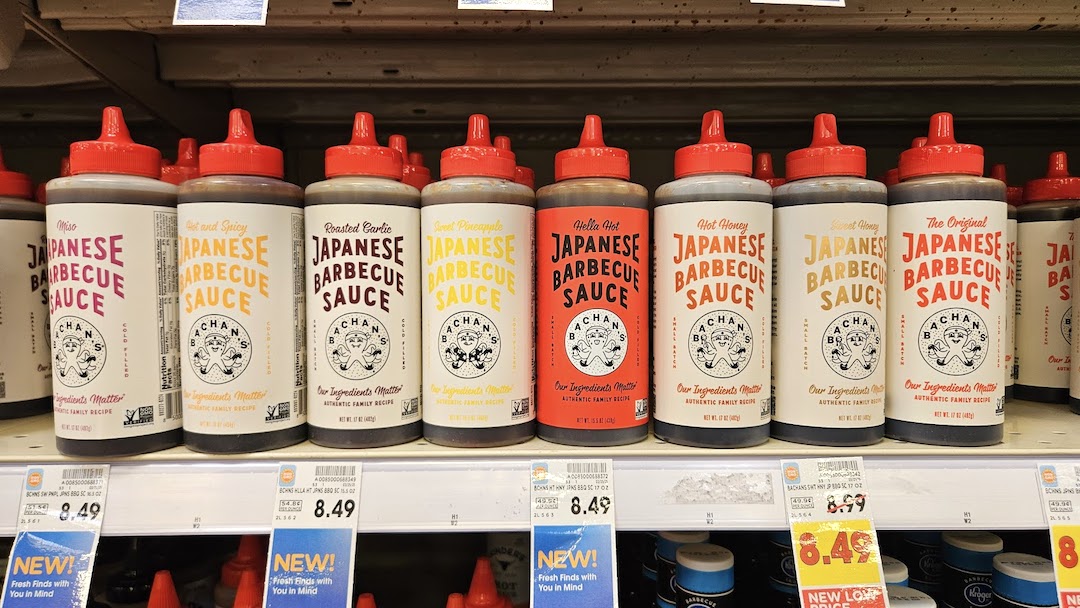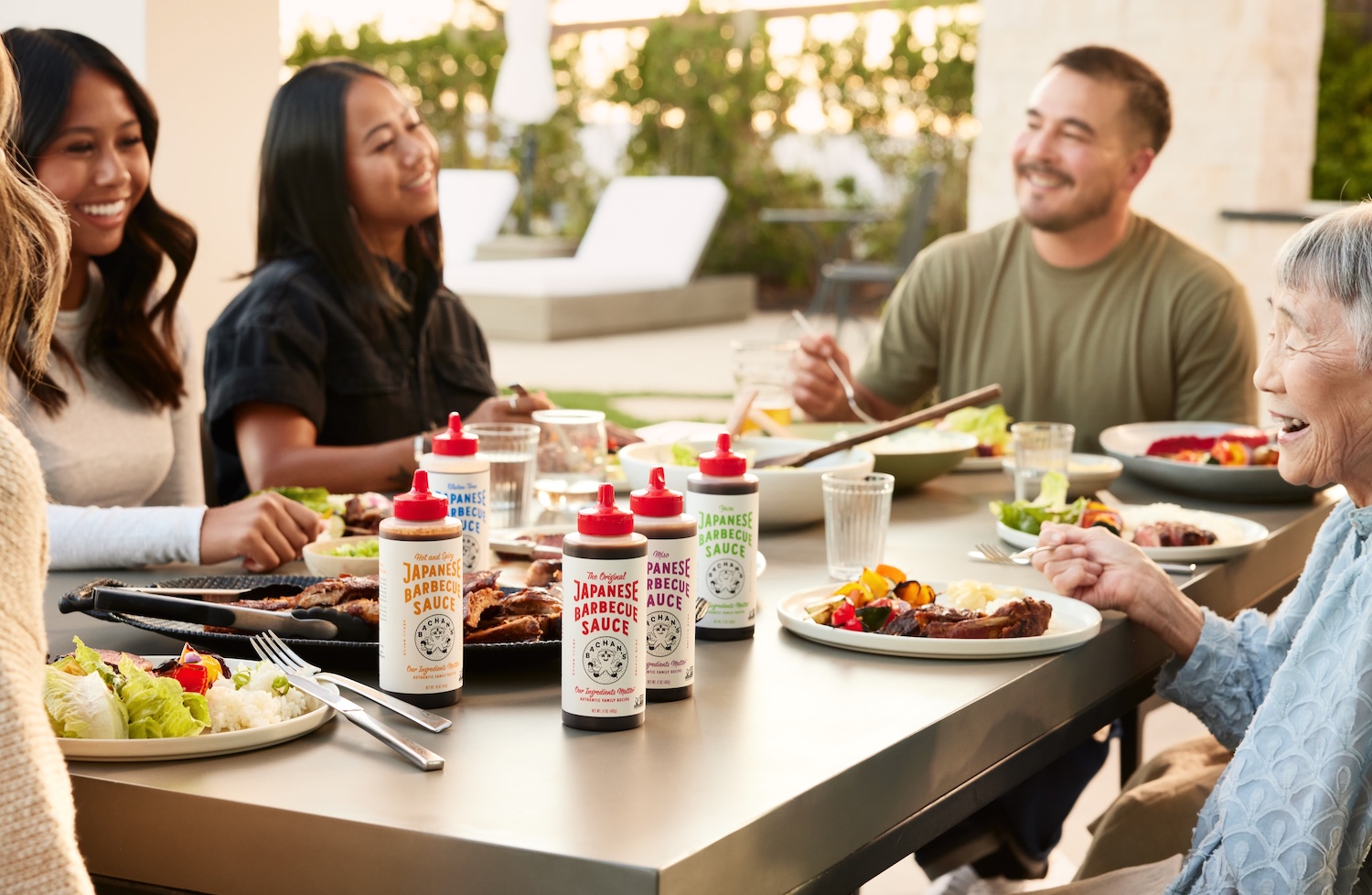Bachan’s Justin Gill with his bachan Judy Yokoyama (Photo: Courtesy of Bachan’s)
Bachan’s BBQ sauce brings Japanese American flavors to the mainstream.
By Gil Asakawa, P.C. Contributor
Last summer, much to many foodies’ surprise, Bachan’s Japanese BBQ Sauce hit the top of the charts as the most popular barbecue sauce sold on Amazon. The popularity wasn’t unexpected — Bachan’s is a delicious, umami-packed, soy-sauce-based condiment.
But barbecue is a category that’s usually dedicated to bottles of tomatoey sauces that are rooted in regional recipes such as Kansas City-, Memphis-, Carolina- or Texas-style flavor profiles to slather on meat.

A variety of Bachan’s BBQ sauces (Photo: Courtesy of Bachan’s)
Bachan’s BBQ Sauce has Japanese roots and comes from a Japanese American family run business based in Sebastopol, Calif., north of San Francisco — not exactly a hotbed of hickory smoke and spareribs.
Read related story here.
Read related story here.
Bachan’s is a brand launched in 2019, but its history goes back to its founder and CEO Justin Gill’s grandmother (yes, Bachan of the company name), Judy Yokoyama.
Yokoyama was a child during World War II when her family was sent from Sebastopol to Amache concentration camp in Colorado. In the decades after the war, when she returned to Northern California, she began cooking with the sweet and salty marinade that became a family favorite, served with beef, chicken and, yes, ribs. The company’s website features recipes for anyone to try.

A variety of Bachan’s BBQ sauces (Photo: Courtesy of Bachan’s)
Gill’s packaging of Bachan’s Japanese BBQ Sauce has been a brilliant blueprint of how a new product born of old traditions can be introduced and then expanded on to the masses. Within a short time, Bachan’s has grown its product lineup to include not just grandma Judy’s Original sauce, but other flavors such as Sweet Pineapple, Roasted Garlic, Hot & Spicy, Sweet Honey, Hot Honey, Hella Hot, Miso and Yuzu Citrus, as well as a Gluten-Free option.
The company has also added thicker Dipping Sauces in Original, as well as Sweet & Spicy flavors, for use with dishes to dip or drizzle over Japanese classics like tonkatsu.
In an email interview, Gill explained the back story of naming Bachan’s. “Japanese barbecue sauce is a term my family and I used to describe our family sauce, and I continued the tradition when bringing Bachan’s to market,” he explained.
But, Gill admitted, “Japanese barbecue sauce isn’t really a thing. While Americans are most familiar with teriyaki sauce, and occasionally describe ourselves as teriyaki-ish to make it easy, Japanese barbecue sauce is technically Japanese Tare sauce. Tare sauce is used for grilling and dipping in Japan. With that in mind, Japanese barbecue sauce is a soy or tamari-based sauce, sweetened with honey or sugar featuring mirin and optional fresh ingredients like ginger and green onion. The consistency tends to be less viscous than American barbecue sauces, which lends itself to a variety of uses from marinading, finishing, dipping, drizzling, dressing and more.”

Bachan’s Founder and CEO Justin Gill.
The brand’s quick popularity and visibility has been a blessing, Gill admitted. It’s available not only online from the bachans.com website and amazon.com, but in national big-box and supermarket chains, as well as, of course, Japanese and Asian markets.
“We’ve been so grateful for the incredibly rapid growth of Bachan’s. It’s been a real whirlwind,” Gill said. “Four years ago, I was in-store with my daughters, sampling the sauce throughout the Bay Area. Today, we’re available nationwide in more than 25,000 stores, including Whole Foods, Sprouts, Target, Walmart, Costco, Albertson’s, Publix and many more.”
The ultimate goal he has for his grandmother’s sauce, Gill said, is to make it ubiquitous. “My dream has always been for Bachan’s to become a condiment staple, and we’re on our way. As the business has grown, so have the challenges. We have a lot of big things locked in for the next few years, and we need to execute on them. If we can continue to execute in the way that we always have, there is a very bright future for Bachan’s and my family legacy.”
One of the challenges is producing a culinary product that reflects Japanese culture and educating people to the foodways that Yokoyama grew up with and handed down to her children and her grandson, Gill.

Justin Gill with his Bachan and family
“Bachan’s mission is to bring families together through food, culture and family,” Gill explained. “This purpose directly seeks to not only bring nuclear families to the table to enjoy food together, but also bring society together as a whole through new cultural flavors, experiences, awareness and discussions.”
Bachan’s sauces are reviewed often by non-Japanese foodies on social media and on YouTube, and the brand is often mispronounced. “I’ve heard every pronunciation of Bachan’s over the years, and I think it’s normal when introducing non-English words into American culture,” Gill said. “I’m sure Sriracha and açaí had the same struggles in the beginning. It’s an ongoing process, and I’m honored to be in a position to share our family’s sauce and story in the hopes it will bring new flavors and experiences to everyone who tries it.”
One future frontier on the horizon: launching Bachan’s in Japan, where Gill has attended the major food trade show. “Every year at the big EXPOWest Trade Show, we get a number of people from Japan and Japanese Americans by our booth expressing their love for our sauce,” he said. “I’d like to think that Bachan’s could succeed in Japan. It would be a huge honor.”
This article was made possible by the Harry K. Honda Memorial Journalism Fund, which was established by JACL Redress Strategist Grant Ujifusa.




